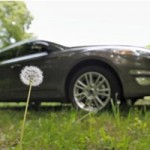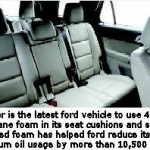The Explorer design – inside and out – is executed with world-class craftsmanship. Tight margin gaps are just one indication of the immense attention to detail applied to craftsmanship across the spectrum, from design to engineering to manufacturing.

Interior of 2011 Ford Explorer
The Chicago facility where Explorer will be produced raised the bar on initial quality measures with the recent Taurus launch, which is good news for customers.
“Crafting a high-quality vehicle is like preparing a gourmet meal,” said Peter Bejin, Craftsmanship Supervisor. “You start with high-quality ingredients, execute your recipe with flawless preparation and finally, present it with flair and panache.”
Quietness – another profound advancement in the all-new 2011 Ford Explorer – also will signal quality to customers.
The team enhanced noise, vibration and harshness (NVH) control for the all-new Explorer using an advanced technology called NoiseVision. A ball with hundreds of tiny cameras and microphones, NoiseVision allows engineers to pinpoint and address potential noise issues earlier in the development process.
Explorer is expected to be superior to in-segment competitors and rival premium SUVs in quietness and NVH control.
Explorer Safety – Strength, Technology and Innovation
The all-new Explorer targets top safety ratings with a stiff unibody structure and a class-leading suite of active and passive safety features and technologies, plus another Ford safety innovation – the world’s first second-row inflatable rear belts.
Rear seat passengers – often children or mature passengers – can be more vulnerable to head, chest and neck injuries. Ford’s unique inflatable rear belts spread impact forces across more than five times the area than conventional seat belts, reducing pressure on the chest while helping to control head and neck motion. Belt comfort should also help increase usage rates. Studies show inflatable belts to be more comfortable for passengers due to padding.
From the boron front bumper beam through the hydroformed front frame rails and high-strength steel side-impact tubes, Explorer’s rigid body structure is designed to provide robust protection for occupants. In the instance of a crash, these elements come together to protect Explorer driver and passengers inside a safety cage of strength.
Standard Explorer safety features include:
- AdvanceTracwith RSC features Curve Control functionality to provide braking – optimized by each individual wheel
- Second-generation first-row airbags, side seat airbags
- Belt-Minder® for driver and first-row passenger
- Front passenger sensing system
- Energy-management system pretensioning for height-adjustable first-row seat belts
- LATCH (Lower Anchors and Tethers for Children) system for outboard second-row positions, for safely securing child safety seats
- SOS Post-Crash Alert System™
- Safety Canopy® side curtain airbags
- Tire Pressure Monitoring System
Available Explorer safety features include:
- Adaptive cruise control and collision warning with brake support
- BLIS® (Blind Spot Information System) with cross-traffic alert
Stretching the Breadth of Capability
The 2011 Ford Explorer redefines customer expectations for driving dynamics and comfort – on any road, anytime, anywhere – while stretching the breadth of SUV capability. Transforming Explorer’s driving quality was central to creating an SUV for 21st century customers.
“Our objectives for Explorer dynamics were three-fold,” said Carl Widmann, Vehicle Engineering Manager. “The first element was to greatly increase on-road comfort, capability and driving dynamics. The second was to maintain the ‘any road, anytime, anywhere’ capability of the previous model. Finally, we aimed to apply technology to the task of safely towing, as V6 Explorer models are rated up to 5,000 pounds. We think customers will be pleased with the next-generation Explorer on all three counts.”
The theme of the all-new Explorer dynamics development was balance. The team sought to provide an engaging driver experience in harmony with the extended breadth of 4WD capability to build driver confidence.
The shift to a unibody construction platform enabled a reduction in road noise and significantly decreased Explorer body roll in dynamic cornering situations. Independent front suspension is of the short- and long-arm configuration with a 32-millimeter front stabilizer bar. Independent rear suspension is the SR1 configuration, so-named for its one-to-one shock absorber ratio, which enables precise ride control.
Explorer’s EPAS system allows for variable rates of assistance based on speed, turn-in and direction. In addition to optimized steering feel, tight on-centering and appropriate resistance, EPAS provides a fuel economy benefit in comparison to traditional hydraulic power assist systems. EPAS also enables a competitive turning radius for optimum maneuverability in parking situations, combined with increased assistance at low speeds for parking ease.








